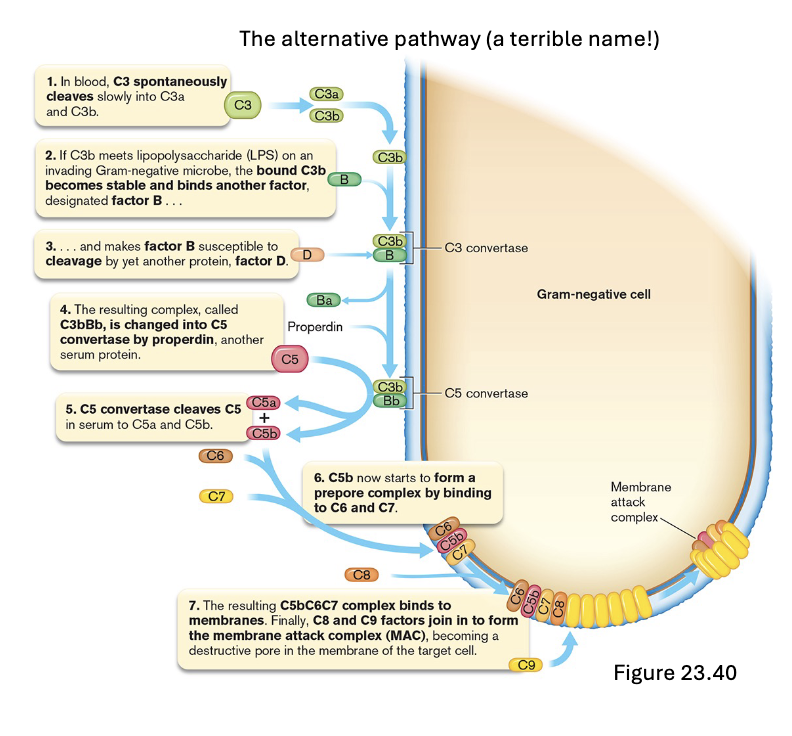Complement system and innate immunity
1/27
There's no tags or description
Looks like no tags are added yet.
Name | Mastery | Learn | Test | Matching | Spaced |
|---|
No study sessions yet.
28 Terms
Were surrounded by microbes so why are we not always sick?
Because not all microbes are pathogenic
Because we have physical and chemical barriers
What happens when our physical and chemical barriers are breached?
The immune system comes into play
Immune system
a highly complex system of organs, tissues, cells and cell products that work together to recognize and neutralize potentially pathogenic threats
Is the immune system capable of responding to almost any foreign molecule?
Yes
Two arms of the immune system
Innate immunity (first to respond)
Adaptive immunity (more specific and develops later
The innate immune system (aka non adaptive or non speciifc)
We are born with this rapid response system that includes physical barriers and chemical/cellular responses which come into play if physical barriers are breached.
Infection
The presence or entry of a microorganism into the body; may or may not lead to disease.
What three things must a pathogen do to cause disease?
Breach host defenses
Survive innate immune responses
Begin to multiply within the host
Physical barriers of the innate immune system
Skin
Mucous membranes
Lungs
Skin as a physical barrier
difficult for microbes to penetrate due to keratin; highly effective when intact.
Mucous membranes as a barrier
Line internal surfaces (~200–300 m²); tightly connected epithelial cells form a strong barrier that is selectively permeable for nutrient absorption.
Lungs as a barrier
Have a mucociliary escalator, a defense mechanism in the lungs that moves trapped particles upward via cilia and mucus to be expelled or swallowed.
microbes larger than 100 micrometres are trapped by hairs in nose and cillia in upper airways, these trigger sneezing to forcefullly remove foreign material from respiratory tract
How are physical barriers (skin, mucosa, lungs) connected to the immune system?
They are linked to lymphoid tissue where specialized immune cells monitor and sample for foreign material.
Immune cells sample physical barrier sites and present antigens to lymph nodes for immune activation if sample is potentially dangerous.
primary lymphoid organs
The factory for lymphoid cells, where immune cells are made and mature (e.g., bone marrow, thymus).
secondary lymphoid organs
Stations for antigen encounters — where immune responses are initiated (e.g., lymph nodes, spleen).
SALT vs GALT
SALT: Skin-Associated Lymphoid Tissue
GALT: Gut-Associated Lymphoid Tissue
These sample their respective areas and surveil for pathogens.
The complement system
trip-wire system with a set of proteins made by the liver that circulate as inactive forms in the blood and enter tissues all over the body. They are proteolytically cleaved to become active.
complement components are named C1-C9
What happens when C3, a protein in the complment system is proteolytically cleaved?
it becomes activated and is separated into two parts C3a and C3b, each with different immune functions.
Why is C3 so important in the complement system?
It’s central to all three pathways of complement activation
What are the 3 compliment activation pathways?
The classical pathway
The lectin pathway
The alternate pathway
Which pathway do all 3 of the complment pathways converge on?
the lytic pathway
Which of the three complement pathways is associated with the innate immune system?
Only the alternative pathway!
The alternative pathway
In blood, C3 spontaneously cleaves into C3a and C3b
if c3b meets LPS on an invading gram negative microbe, the bound C3b becomes stable and binds another factor called factor B
Factor B is susceptible to cleavage by factor D
The reuslting complex, called C3bBb, is changed into C5 convertase by properdin, a protein.
C5 convertase cleaves C5 into C5a and C5b (C5 now activated)
Once c5 is activated all the other proteins come together to surface of the bacterial cell form a membrane attack complex (MAC) make a hole in the cell, and when the bacterium has a hole in it, the contents of the cell leaks out and the cell dies.

Why is the alternative pathway name misleading?
It sounds like a backup, but it’s actually the first to activate during infection.
C3b (Opsonin)
A cleavage product of C3 that coats pathogens to enhance phagocytosis by immune cells — acts like a molecular "eat me" tag.
C3a and C5a
act as Anaphylatoxins, directing immune cell traffic to where it is most needed
membrane attack complex (MAC)
punches holes in target bacterial cells killling them.
What are the three main roles of the complement system?
Cripples enemy — by tagging pathogens (C3b) and enhancing phagocytosis.
Activates immune system — by recruiting immune cells (C3a, C5a).
Creates holes in enemy — by forming the Membrane Attack Complex (MAC) to kill pathogens.